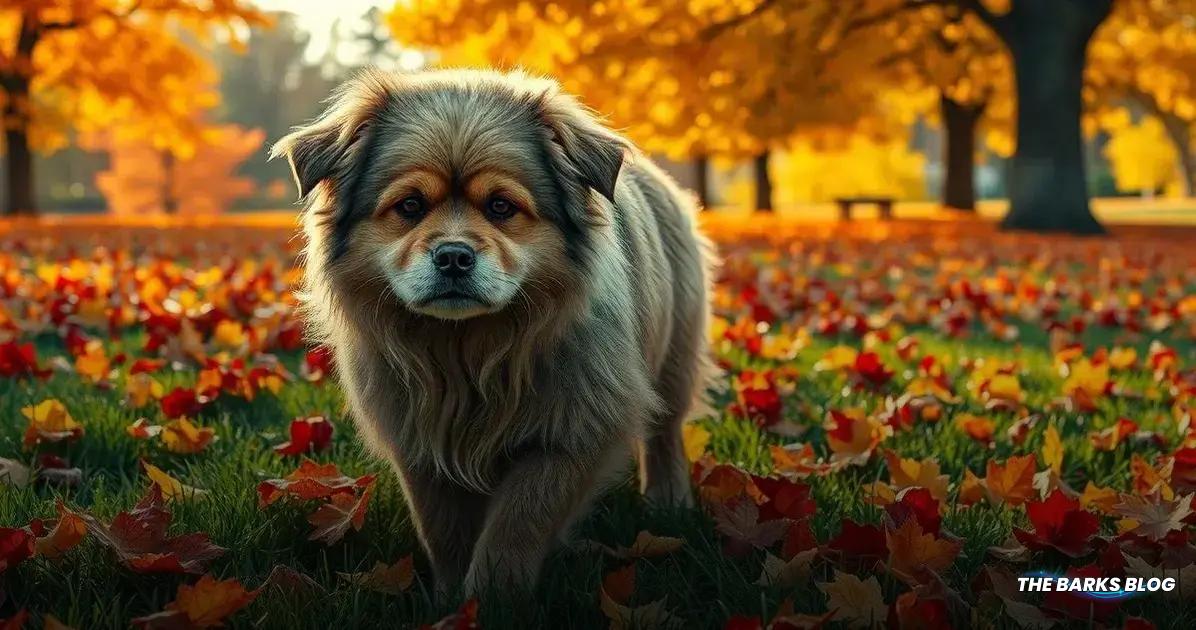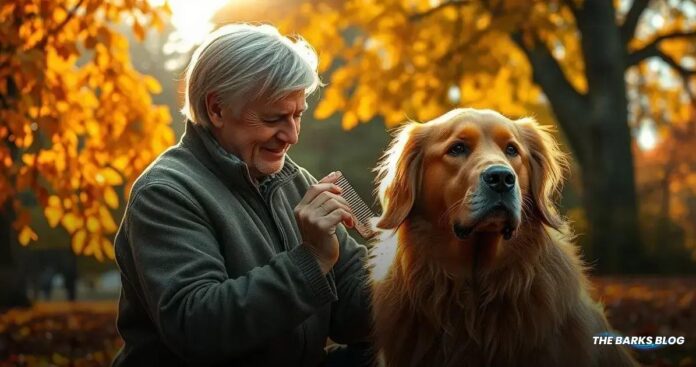To remove and prevent burrs from attaching to your dog’s fur, pet owners should prepare their dogs, gather necessary tools, and follow a step-by-step process that includes soothing the dog, crushing the burrs, and applying oil for stubborn cases. Preventive measures like avoiding wooded areas, regular grooming, and checking for burrs after walks can help minimize the issue, ensuring dogs remain comfortable and healthy during outdoor activities.
As fall arrives, burrs can become a common nuisance for our furry friends. These pesky seeds cling to their fur, causing discomfort and potential irritation. It’s essential for pet parents to know how to remove burrs from dog fur, especially for those with thick or long coats.

Understanding Burrs on Dogs
Burrs on dogs can be a real headache for pet owners, especially during the fall when these pesky seeds are most prevalent. They are typically found in areas where your dog has hair, making them particularly troublesome in sensitive spots like the armpits, between the toes, and around the ears.
These areas are not only more prone to burr attachment but also more sensitive, which can make your dog reluctant to let you help.
Understanding how burrs attach is crucial. Burrs are designed to cling tightly to fur and fabric, often embedding themselves deep into the coat. This is why timely removal is essential; if left unattended, burrs can cause discomfort, irritation, and even lead to infections if they cut into the skin.
This is especially true for dogs with thick undercoats or long fur, as they are more susceptible to these nuisances.
Moreover, burrs can also be a source of anxiety for dogs. The sharp edges can cause pain, and the sensation of having something stuck in their fur can make them feel uneasy.
Therefore, as pet parents, it’s vital to be proactive in checking for and removing burrs, ensuring our pups stay comfortable and happy.

Steps to Remove Burrs from Dog Fur
Removing burrs from your dog’s fur may seem daunting, but with a little patience and the right approach, you can make the process smooth for both you and your pup. Here’s a step-by-step guide to help you:
- Prepare Your Dog: Start by making your dog feel comfortable. Use soothing tones and have their favorite treats on hand to reward them for their patience during the process. It might also help to have a second person to gently hold your dog if they get restless.
- Gather Your Supplies: Before you begin, make sure you have everything you need. Put on a pair of gloves to protect your hands. You’ll need a wide-toothed comb (preferably metal), some olive oil or any safe oil for dogs, and a pair of pliers.
- Identify the Burrs: Look for the burrs that are easiest to remove first. This will help your dog get used to the process without feeling overwhelmed. Start with the burrs that look the loosest.
- Crush the Burrs: Use the pliers to gently crush the burrs. This will break them into smaller pieces, making it easier to remove them without pulling on your dog’s fur, which can cause pain.
- Comb Out the Burrs: With the comb, gently work out the smaller pieces of the burr. Keep your hand between the burr and your dog’s skin to prevent the burr from reattaching, and always comb away from the root of the fur.
- Use Oil for Stubborn Burrs: If the burrs are particularly stubborn, applying a small amount of olive oil can help lubricate them for easier removal. Just make sure to use oils that are safe for dogs.
- Consider Shaving if Necessary: In severe cases where burrs are deeply embedded and won’t come out, you might need to shave the area. Use a shaver to minimize the risk of cutting your dog’s skin, and keep the atmosphere calm with soothing words and treats.
- Check for Residue: After removing the burrs, it’s a good idea to bathe your dog to remove any oily residue left from the oil used during the process.
- Seek Professional Help: If you’re unsure or uncomfortable with removing burrs, don’t hesitate to contact your vet or a professional groomer for assistance.
By following these steps, you can help ensure your dog stays comfortable and burr-free!

Preventing Burrs from Attaching to Your Dog
Preventing burrs from attaching to your dog is much easier than dealing with them after they’ve already taken hold. Here are some effective strategies to keep your furry friend burr-free:
- Avoid Wooded Areas: The simplest way to prevent burrs is to avoid walking your dog in areas where burrs are prevalent, especially during the fall season when they are most abundant. If possible, stick to paved paths or grassy areas that are less likely to have burrs.
- Use a Short Leash: Keeping your dog on a short leash during walks in wooded or grassy areas can help reduce the chances of them getting burrs. This allows you to have better control and prevents them from wandering into dense vegetation where burrs are more likely to cling.
- Regular Grooming: Maintaining a regular grooming routine is essential. Brushing your dog’s fur frequently helps to remove loose hair and prevents burrs from getting tangled in their coat. For dogs with longer fur, consider using a slicker brush or a comb designed for detangling.
- Trim Fur as Needed: Keeping your dog’s fur trimmed, especially in areas where burrs tend to cling, can significantly reduce the risk of attachment. Shorter fur is less likely to trap burrs, making it easier to manage.
- Check After Walks: Always check your dog for burrs after walks, especially in sensitive areas like the ears, paws, and underbelly. The sooner you catch them, the easier they are to remove.
- Use Protective Clothing: If your dog is prone to burrs, consider using protective clothing, like a doggy sweater or a coat, during walks in burr-heavy areas. This can act as a barrier and help keep burrs from getting to their fur.
- Keep Your Yard Clean: If your dog spends a lot of time in your yard, regularly check and clean up any burr-producing plants or weeds. Keeping your outdoor space tidy can help prevent burrs from becoming a problem at home.
By taking these preventive measures, you can help keep your dog comfortable and burr-free, allowing them to enjoy their outdoor adventures without the hassle of pesky burrs!
Conclusion
In conclusion, understanding how to effectively remove and prevent burrs from attaching to your dog’s fur is crucial for their comfort and well-being.
With the right approach, including preparing your dog, using the right tools, and implementing preventive measures, you can ensure that your furry friend enjoys their outdoor adventures without the discomfort of burrs.
Regular grooming and vigilance after walks will go a long way in keeping burrs at bay, allowing your dog to play freely and happily.
If you ever feel uncertain about the removal process, remember that seeking help from a professional groomer or your veterinarian is always a good option.
Keeping your dog burr-free means more enjoyable walks and a happier pup!
FAQ – Frequently Asked Questions about Removing Burrs from Dog Fur
What are burrs and why do they stick to my dog’s fur?
Burrs are seed pods that cling to fur and fabric due to their unique structure. They attach easily to your dog’s fur, especially in areas with longer or thicker coats.
How can I tell if my dog has burrs in their fur?
Check for areas of discomfort or irritation, especially in sensitive spots like the armpits, between toes, and around the ears. You may also see the burrs visibly sticking to their fur.
What should I do if my dog swallows a burr?
If your dog swallows a burr and shows no signs of distress, they will likely digest it naturally. However, if they exhibit symptoms like coughing, excessive drooling, or difficulty breathing, seek veterinary help immediately.
Can I use regular oil to help remove burrs from my dog’s fur?
Yes, you can use safe oils like olive oil or coconut oil to lubricate stubborn burrs for easier removal. Just ensure the oil is safe for your dog to lick.
How often should I check my dog for burrs?
It’s a good practice to check your dog for burrs after every walk, especially if you’ve been in areas where burrs are common, like wooded or grassy regions.
What are some effective ways to prevent burrs from attaching to my dog’s fur?
To prevent burrs, avoid walking in wooded areas during burr season, keep your dog on a short leash, groom them regularly, and consider using protective clothing.




